Report: Principles of Administration in Office Management
VerifiedAdded on 2020/06/03
|16
|3963
|66
Report
AI Summary
This report provides a comprehensive overview of the principles of administration, covering various aspects of office management. It begins by outlining legal requirements related to office facility management, typical services provided, and how to establish effective office procedures. The report then delves into the legal obligations of employers and individuals regarding health and safety in the workplace, including accident and emergency procedures. Furthermore, it examines the purpose, legal implications, and importance of accuracy in meeting minutes, along with techniques for note-taking. The report also explores different types of meetings, the roles and responsibilities of participants, and facilitation techniques. It discusses the use of targets and budgets, work allocation, quality management, and identifying areas for improvement within an administration team. Finally, the report covers the characteristics, requirements, and planning of different types of events, including information needs of delegates before, during, and after an event. The report concludes with a concise summary of the key takeaways from each section, providing a holistic understanding of administration principles.
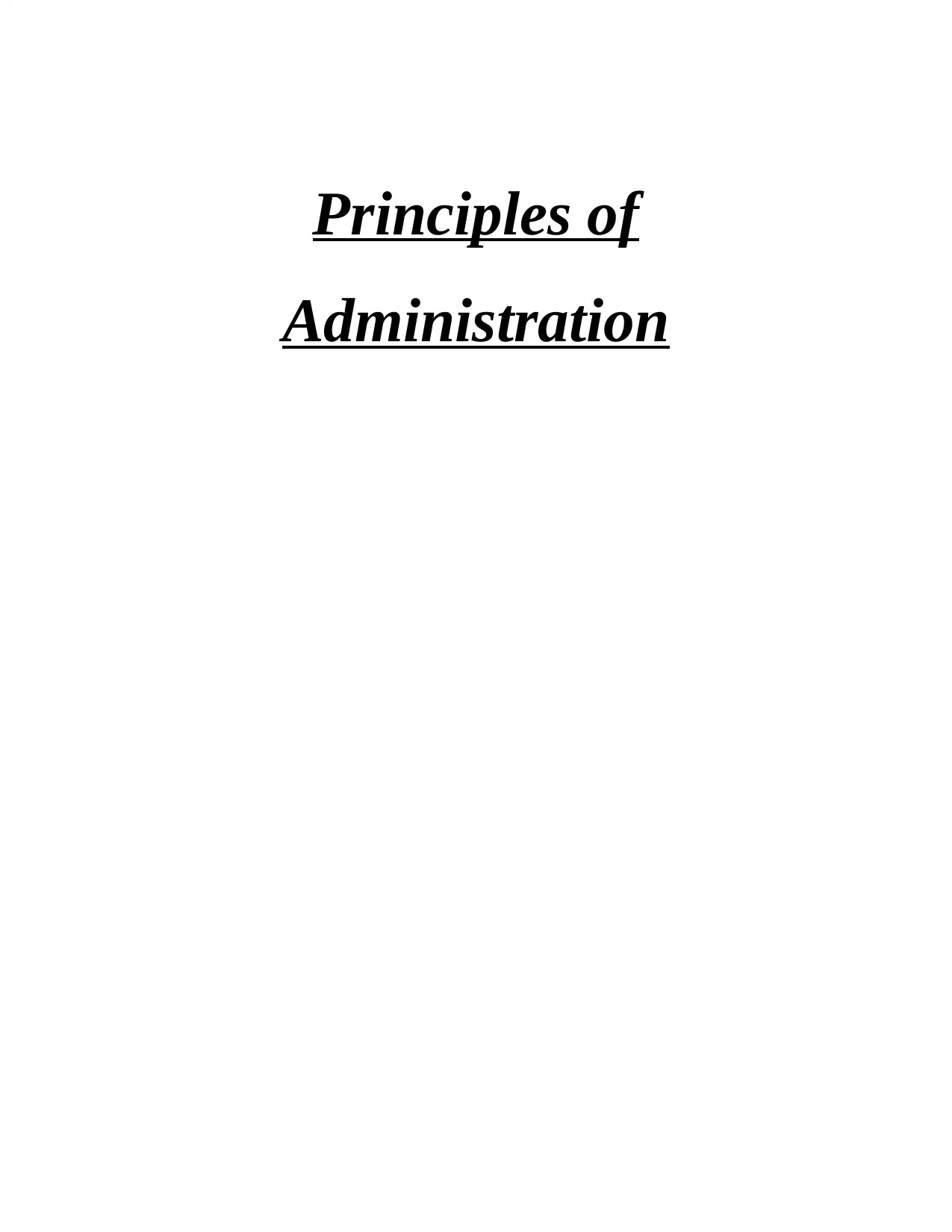
Principles of
Administration
Administration
Paraphrase This Document
Need a fresh take? Get an instant paraphrase of this document with our AI Paraphraser
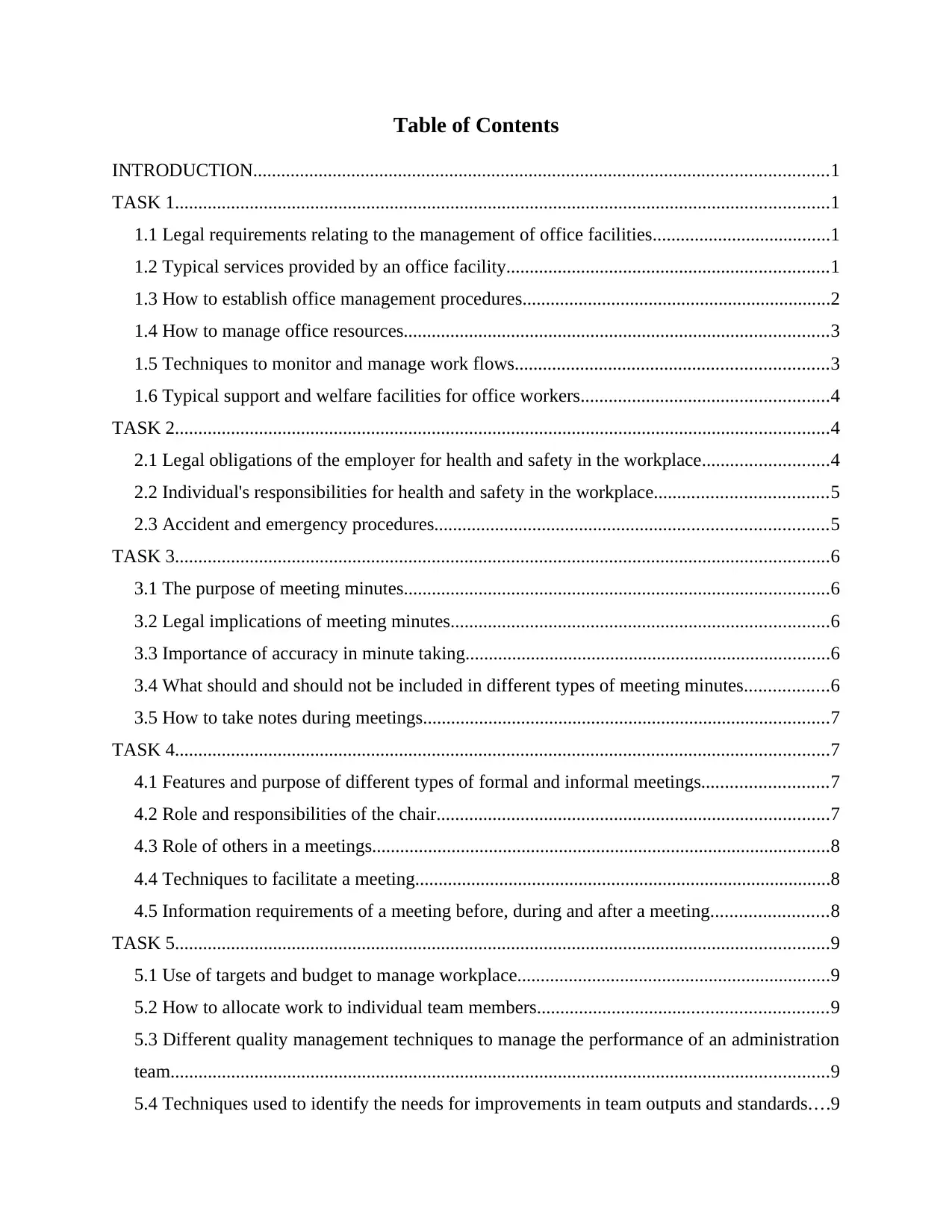
Table of Contents
INTRODUCTION...........................................................................................................................1
TASK 1............................................................................................................................................1
1.1 Legal requirements relating to the management of office facilities......................................1
1.2 Typical services provided by an office facility.....................................................................1
1.3 How to establish office management procedures..................................................................2
1.4 How to manage office resources...........................................................................................3
1.5 Techniques to monitor and manage work flows...................................................................3
1.6 Typical support and welfare facilities for office workers.....................................................4
TASK 2............................................................................................................................................4
2.1 Legal obligations of the employer for health and safety in the workplace...........................4
2.2 Individual's responsibilities for health and safety in the workplace.....................................5
2.3 Accident and emergency procedures....................................................................................5
TASK 3............................................................................................................................................6
3.1 The purpose of meeting minutes...........................................................................................6
3.2 Legal implications of meeting minutes.................................................................................6
3.3 Importance of accuracy in minute taking..............................................................................6
3.4 What should and should not be included in different types of meeting minutes..................6
3.5 How to take notes during meetings.......................................................................................7
TASK 4............................................................................................................................................7
4.1 Features and purpose of different types of formal and informal meetings...........................7
4.2 Role and responsibilities of the chair....................................................................................7
4.3 Role of others in a meetings..................................................................................................8
4.4 Techniques to facilitate a meeting.........................................................................................8
4.5 Information requirements of a meeting before, during and after a meeting.........................8
TASK 5............................................................................................................................................9
5.1 Use of targets and budget to manage workplace...................................................................9
5.2 How to allocate work to individual team members..............................................................9
5.3 Different quality management techniques to manage the performance of an administration
team.............................................................................................................................................9
5.4 Techniques used to identify the needs for improvements in team outputs and standards....9
INTRODUCTION...........................................................................................................................1
TASK 1............................................................................................................................................1
1.1 Legal requirements relating to the management of office facilities......................................1
1.2 Typical services provided by an office facility.....................................................................1
1.3 How to establish office management procedures..................................................................2
1.4 How to manage office resources...........................................................................................3
1.5 Techniques to monitor and manage work flows...................................................................3
1.6 Typical support and welfare facilities for office workers.....................................................4
TASK 2............................................................................................................................................4
2.1 Legal obligations of the employer for health and safety in the workplace...........................4
2.2 Individual's responsibilities for health and safety in the workplace.....................................5
2.3 Accident and emergency procedures....................................................................................5
TASK 3............................................................................................................................................6
3.1 The purpose of meeting minutes...........................................................................................6
3.2 Legal implications of meeting minutes.................................................................................6
3.3 Importance of accuracy in minute taking..............................................................................6
3.4 What should and should not be included in different types of meeting minutes..................6
3.5 How to take notes during meetings.......................................................................................7
TASK 4............................................................................................................................................7
4.1 Features and purpose of different types of formal and informal meetings...........................7
4.2 Role and responsibilities of the chair....................................................................................7
4.3 Role of others in a meetings..................................................................................................8
4.4 Techniques to facilitate a meeting.........................................................................................8
4.5 Information requirements of a meeting before, during and after a meeting.........................8
TASK 5............................................................................................................................................9
5.1 Use of targets and budget to manage workplace...................................................................9
5.2 How to allocate work to individual team members..............................................................9
5.3 Different quality management techniques to manage the performance of an administration
team.............................................................................................................................................9
5.4 Techniques used to identify the needs for improvements in team outputs and standards....9
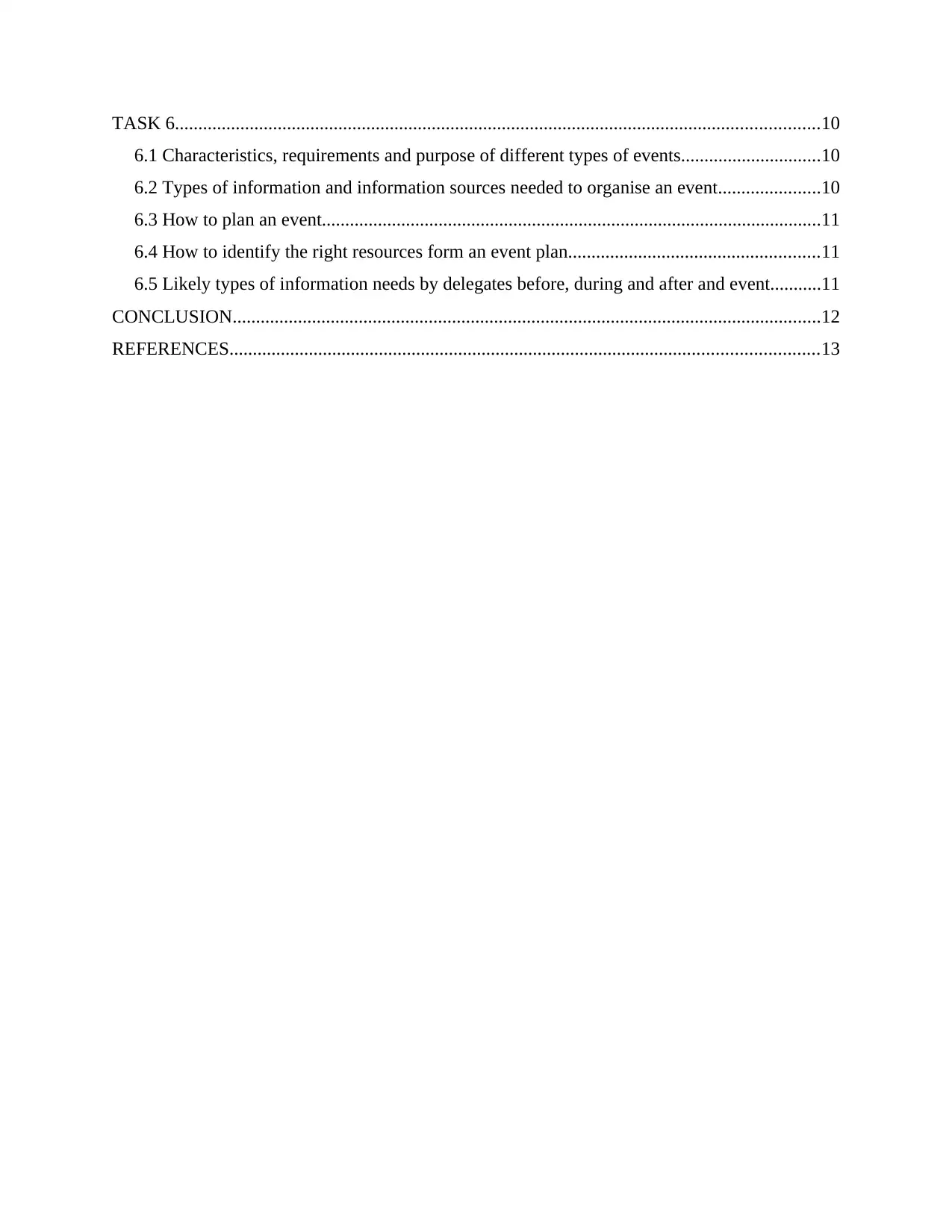
TASK 6..........................................................................................................................................10
6.1 Characteristics, requirements and purpose of different types of events..............................10
6.2 Types of information and information sources needed to organise an event......................10
6.3 How to plan an event...........................................................................................................11
6.4 How to identify the right resources form an event plan......................................................11
6.5 Likely types of information needs by delegates before, during and after and event...........11
CONCLUSION..............................................................................................................................12
REFERENCES..............................................................................................................................13
6.1 Characteristics, requirements and purpose of different types of events..............................10
6.2 Types of information and information sources needed to organise an event......................10
6.3 How to plan an event...........................................................................................................11
6.4 How to identify the right resources form an event plan......................................................11
6.5 Likely types of information needs by delegates before, during and after and event...........11
CONCLUSION..............................................................................................................................12
REFERENCES..............................................................................................................................13
⊘ This is a preview!⊘
Do you want full access?
Subscribe today to unlock all pages.

Trusted by 1+ million students worldwide
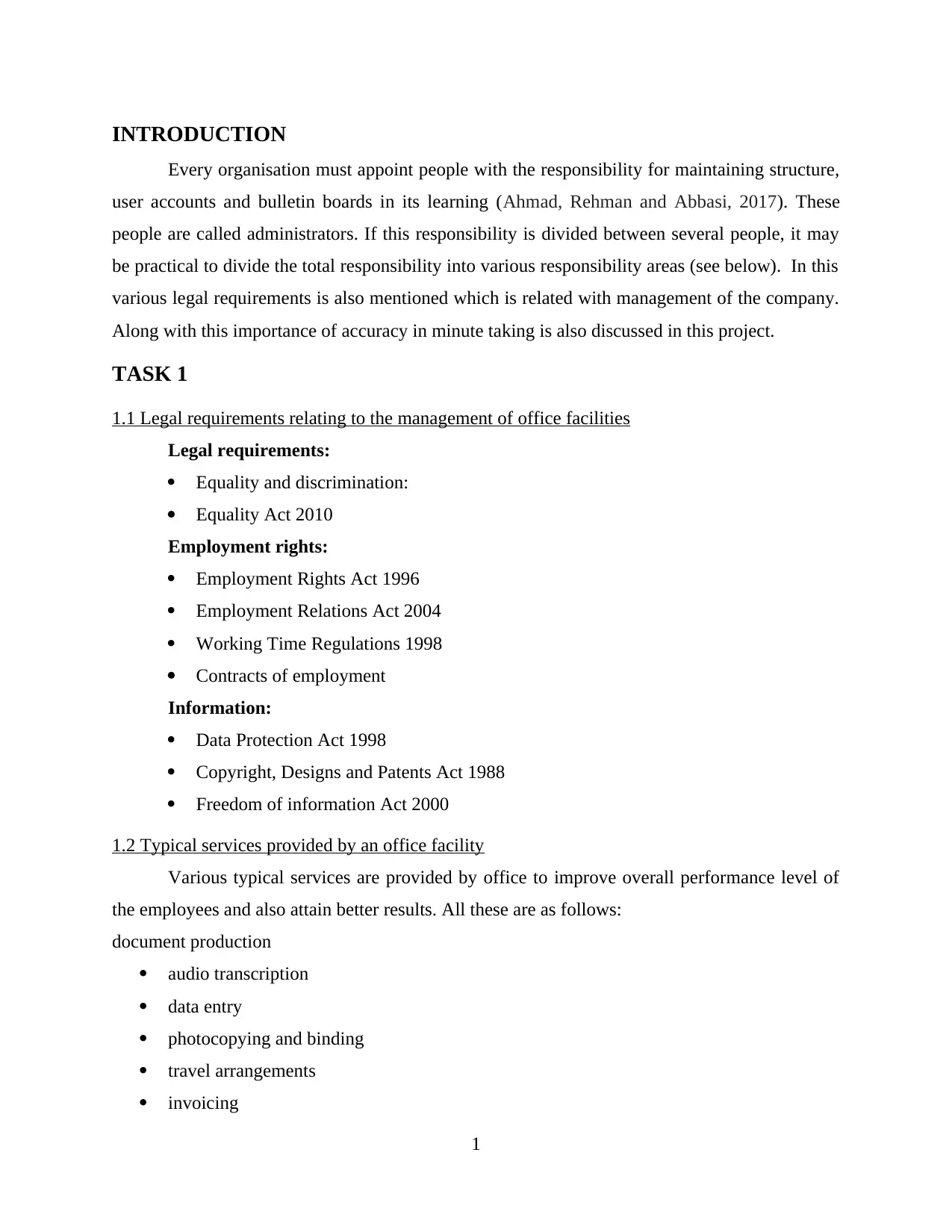
INTRODUCTION
Every organisation must appoint people with the responsibility for maintaining structure,
user accounts and bulletin boards in its learning (Ahmad, Rehman and Abbasi, 2017). These
people are called administrators. If this responsibility is divided between several people, it may
be practical to divide the total responsibility into various responsibility areas (see below). In this
various legal requirements is also mentioned which is related with management of the company.
Along with this importance of accuracy in minute taking is also discussed in this project.
TASK 1
1.1 Legal requirements relating to the management of office facilities
Legal requirements:
Equality and discrimination:
Equality Act 2010
Employment rights:
Employment Rights Act 1996
Employment Relations Act 2004
Working Time Regulations 1998
Contracts of employment
Information:
Data Protection Act 1998
Copyright, Designs and Patents Act 1988
Freedom of information Act 2000
1.2 Typical services provided by an office facility
Various typical services are provided by office to improve overall performance level of
the employees and also attain better results. All these are as follows:
document production
audio transcription
data entry
photocopying and binding
travel arrangements
invoicing
1
Every organisation must appoint people with the responsibility for maintaining structure,
user accounts and bulletin boards in its learning (Ahmad, Rehman and Abbasi, 2017). These
people are called administrators. If this responsibility is divided between several people, it may
be practical to divide the total responsibility into various responsibility areas (see below). In this
various legal requirements is also mentioned which is related with management of the company.
Along with this importance of accuracy in minute taking is also discussed in this project.
TASK 1
1.1 Legal requirements relating to the management of office facilities
Legal requirements:
Equality and discrimination:
Equality Act 2010
Employment rights:
Employment Rights Act 1996
Employment Relations Act 2004
Working Time Regulations 1998
Contracts of employment
Information:
Data Protection Act 1998
Copyright, Designs and Patents Act 1988
Freedom of information Act 2000
1.2 Typical services provided by an office facility
Various typical services are provided by office to improve overall performance level of
the employees and also attain better results. All these are as follows:
document production
audio transcription
data entry
photocopying and binding
travel arrangements
invoicing
1
Paraphrase This Document
Need a fresh take? Get an instant paraphrase of this document with our AI Paraphraser
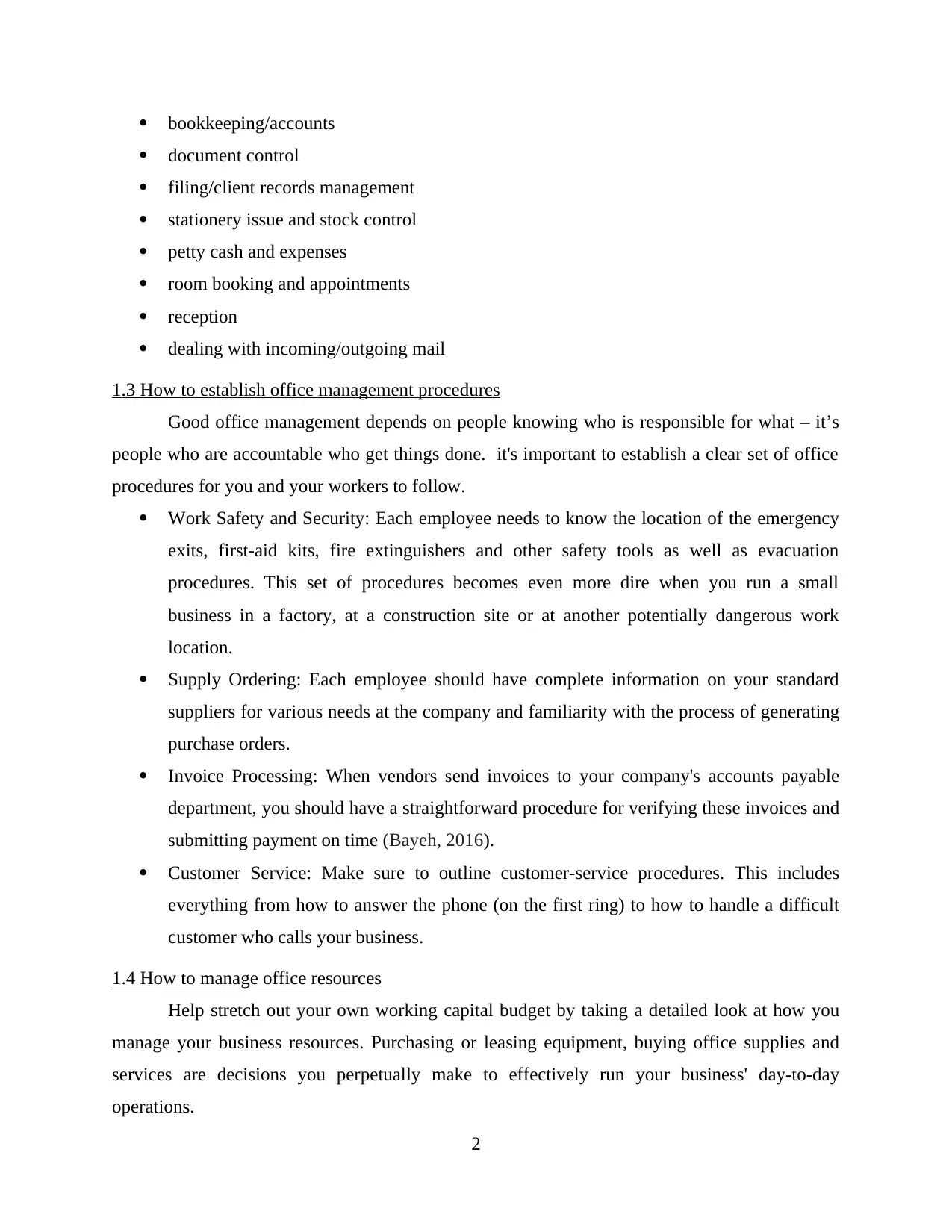
bookkeeping/accounts
document control
filing/client records management
stationery issue and stock control
petty cash and expenses
room booking and appointments
reception
dealing with incoming/outgoing mail
1.3 How to establish office management procedures
Good office management depends on people knowing who is responsible for what – it’s
people who are accountable who get things done. it's important to establish a clear set of office
procedures for you and your workers to follow.
Work Safety and Security: Each employee needs to know the location of the emergency
exits, first-aid kits, fire extinguishers and other safety tools as well as evacuation
procedures. This set of procedures becomes even more dire when you run a small
business in a factory, at a construction site or at another potentially dangerous work
location.
Supply Ordering: Each employee should have complete information on your standard
suppliers for various needs at the company and familiarity with the process of generating
purchase orders.
Invoice Processing: When vendors send invoices to your company's accounts payable
department, you should have a straightforward procedure for verifying these invoices and
submitting payment on time (Bayeh, 2016).
Customer Service: Make sure to outline customer-service procedures. This includes
everything from how to answer the phone (on the first ring) to how to handle a difficult
customer who calls your business.
1.4 How to manage office resources
Help stretch out your own working capital budget by taking a detailed look at how you
manage your business resources. Purchasing or leasing equipment, buying office supplies and
services are decisions you perpetually make to effectively run your business' day-to-day
operations.
2
document control
filing/client records management
stationery issue and stock control
petty cash and expenses
room booking and appointments
reception
dealing with incoming/outgoing mail
1.3 How to establish office management procedures
Good office management depends on people knowing who is responsible for what – it’s
people who are accountable who get things done. it's important to establish a clear set of office
procedures for you and your workers to follow.
Work Safety and Security: Each employee needs to know the location of the emergency
exits, first-aid kits, fire extinguishers and other safety tools as well as evacuation
procedures. This set of procedures becomes even more dire when you run a small
business in a factory, at a construction site or at another potentially dangerous work
location.
Supply Ordering: Each employee should have complete information on your standard
suppliers for various needs at the company and familiarity with the process of generating
purchase orders.
Invoice Processing: When vendors send invoices to your company's accounts payable
department, you should have a straightforward procedure for verifying these invoices and
submitting payment on time (Bayeh, 2016).
Customer Service: Make sure to outline customer-service procedures. This includes
everything from how to answer the phone (on the first ring) to how to handle a difficult
customer who calls your business.
1.4 How to manage office resources
Help stretch out your own working capital budget by taking a detailed look at how you
manage your business resources. Purchasing or leasing equipment, buying office supplies and
services are decisions you perpetually make to effectively run your business' day-to-day
operations.
2
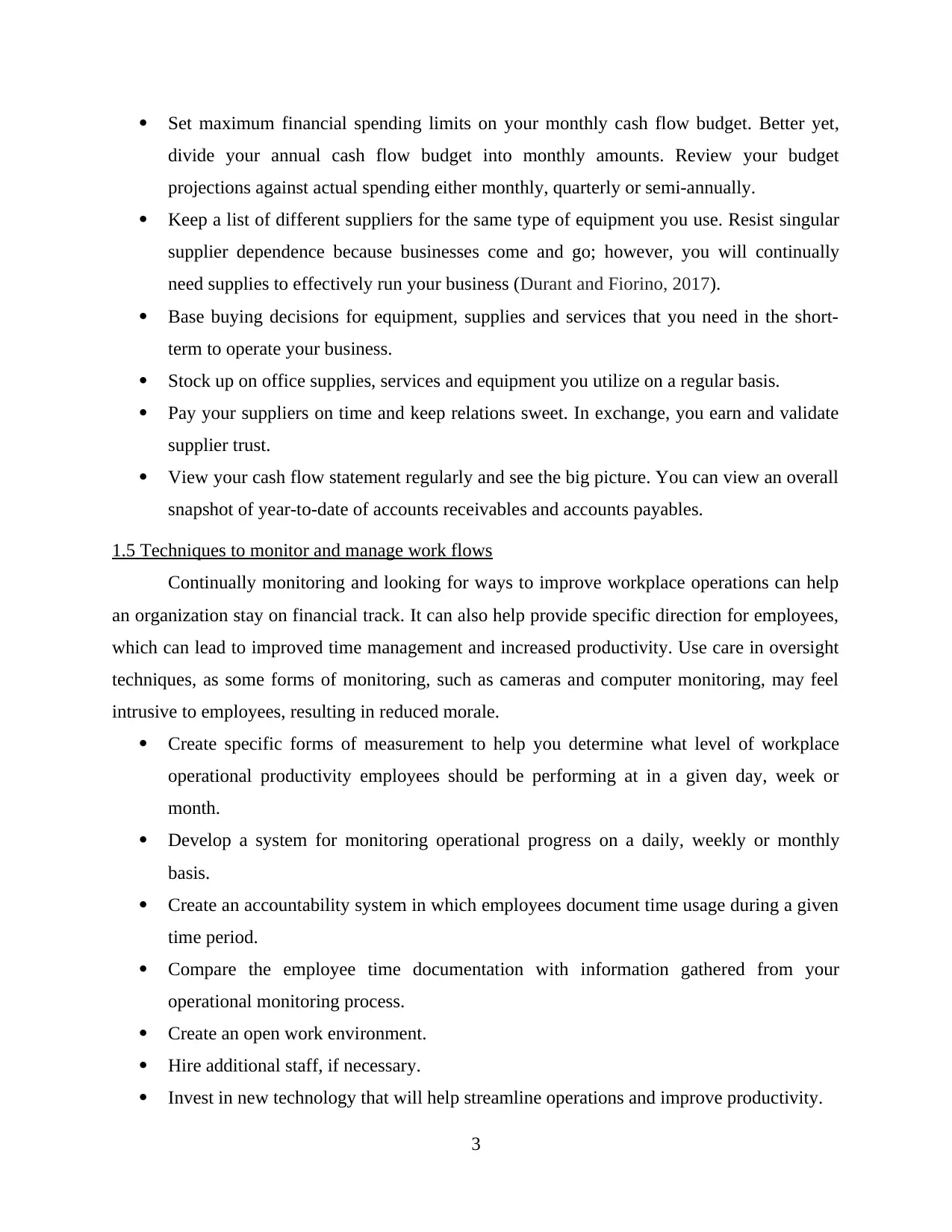
Set maximum financial spending limits on your monthly cash flow budget. Better yet,
divide your annual cash flow budget into monthly amounts. Review your budget
projections against actual spending either monthly, quarterly or semi-annually.
Keep a list of different suppliers for the same type of equipment you use. Resist singular
supplier dependence because businesses come and go; however, you will continually
need supplies to effectively run your business (Durant and Fiorino, 2017).
Base buying decisions for equipment, supplies and services that you need in the short-
term to operate your business.
Stock up on office supplies, services and equipment you utilize on a regular basis.
Pay your suppliers on time and keep relations sweet. In exchange, you earn and validate
supplier trust.
View your cash flow statement regularly and see the big picture. You can view an overall
snapshot of year-to-date of accounts receivables and accounts payables.
1.5 Techniques to monitor and manage work flows
Continually monitoring and looking for ways to improve workplace operations can help
an organization stay on financial track. It can also help provide specific direction for employees,
which can lead to improved time management and increased productivity. Use care in oversight
techniques, as some forms of monitoring, such as cameras and computer monitoring, may feel
intrusive to employees, resulting in reduced morale.
Create specific forms of measurement to help you determine what level of workplace
operational productivity employees should be performing at in a given day, week or
month.
Develop a system for monitoring operational progress on a daily, weekly or monthly
basis.
Create an accountability system in which employees document time usage during a given
time period.
Compare the employee time documentation with information gathered from your
operational monitoring process.
Create an open work environment.
Hire additional staff, if necessary.
Invest in new technology that will help streamline operations and improve productivity.
3
divide your annual cash flow budget into monthly amounts. Review your budget
projections against actual spending either monthly, quarterly or semi-annually.
Keep a list of different suppliers for the same type of equipment you use. Resist singular
supplier dependence because businesses come and go; however, you will continually
need supplies to effectively run your business (Durant and Fiorino, 2017).
Base buying decisions for equipment, supplies and services that you need in the short-
term to operate your business.
Stock up on office supplies, services and equipment you utilize on a regular basis.
Pay your suppliers on time and keep relations sweet. In exchange, you earn and validate
supplier trust.
View your cash flow statement regularly and see the big picture. You can view an overall
snapshot of year-to-date of accounts receivables and accounts payables.
1.5 Techniques to monitor and manage work flows
Continually monitoring and looking for ways to improve workplace operations can help
an organization stay on financial track. It can also help provide specific direction for employees,
which can lead to improved time management and increased productivity. Use care in oversight
techniques, as some forms of monitoring, such as cameras and computer monitoring, may feel
intrusive to employees, resulting in reduced morale.
Create specific forms of measurement to help you determine what level of workplace
operational productivity employees should be performing at in a given day, week or
month.
Develop a system for monitoring operational progress on a daily, weekly or monthly
basis.
Create an accountability system in which employees document time usage during a given
time period.
Compare the employee time documentation with information gathered from your
operational monitoring process.
Create an open work environment.
Hire additional staff, if necessary.
Invest in new technology that will help streamline operations and improve productivity.
3
⊘ This is a preview!⊘
Do you want full access?
Subscribe today to unlock all pages.

Trusted by 1+ million students worldwide
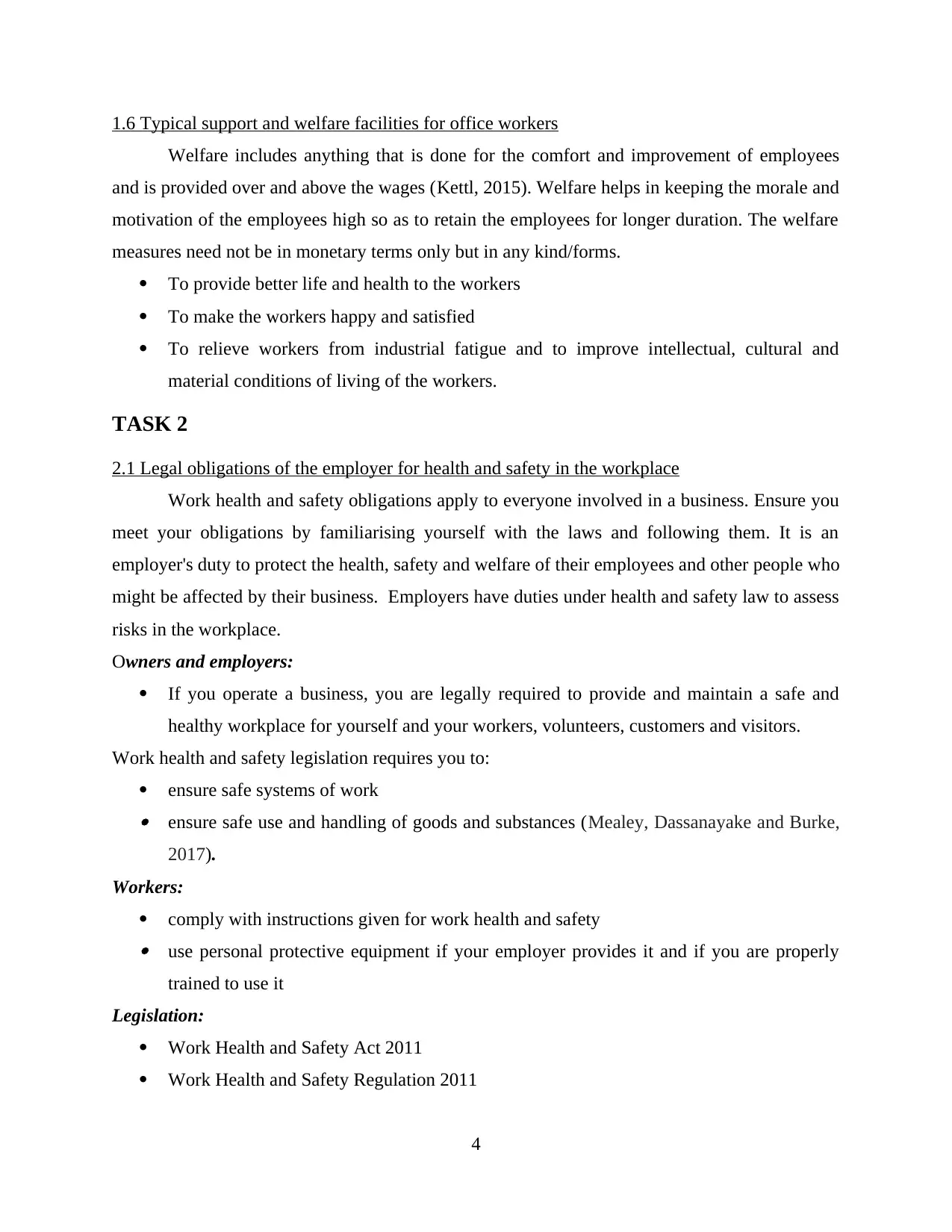
1.6 Typical support and welfare facilities for office workers
Welfare includes anything that is done for the comfort and improvement of employees
and is provided over and above the wages (Kettl, 2015). Welfare helps in keeping the morale and
motivation of the employees high so as to retain the employees for longer duration. The welfare
measures need not be in monetary terms only but in any kind/forms.
To provide better life and health to the workers
To make the workers happy and satisfied
To relieve workers from industrial fatigue and to improve intellectual, cultural and
material conditions of living of the workers.
TASK 2
2.1 Legal obligations of the employer for health and safety in the workplace
Work health and safety obligations apply to everyone involved in a business. Ensure you
meet your obligations by familiarising yourself with the laws and following them. It is an
employer's duty to protect the health, safety and welfare of their employees and other people who
might be affected by their business. Employers have duties under health and safety law to assess
risks in the workplace.
Owners and employers:
If you operate a business, you are legally required to provide and maintain a safe and
healthy workplace for yourself and your workers, volunteers, customers and visitors.
Work health and safety legislation requires you to:
ensure safe systems of work ensure safe use and handling of goods and substances (Mealey, Dassanayake and Burke,
2017).
Workers:
comply with instructions given for work health and safety use personal protective equipment if your employer provides it and if you are properly
trained to use it
Legislation:
Work Health and Safety Act 2011
Work Health and Safety Regulation 2011
4
Welfare includes anything that is done for the comfort and improvement of employees
and is provided over and above the wages (Kettl, 2015). Welfare helps in keeping the morale and
motivation of the employees high so as to retain the employees for longer duration. The welfare
measures need not be in monetary terms only but in any kind/forms.
To provide better life and health to the workers
To make the workers happy and satisfied
To relieve workers from industrial fatigue and to improve intellectual, cultural and
material conditions of living of the workers.
TASK 2
2.1 Legal obligations of the employer for health and safety in the workplace
Work health and safety obligations apply to everyone involved in a business. Ensure you
meet your obligations by familiarising yourself with the laws and following them. It is an
employer's duty to protect the health, safety and welfare of their employees and other people who
might be affected by their business. Employers have duties under health and safety law to assess
risks in the workplace.
Owners and employers:
If you operate a business, you are legally required to provide and maintain a safe and
healthy workplace for yourself and your workers, volunteers, customers and visitors.
Work health and safety legislation requires you to:
ensure safe systems of work ensure safe use and handling of goods and substances (Mealey, Dassanayake and Burke,
2017).
Workers:
comply with instructions given for work health and safety use personal protective equipment if your employer provides it and if you are properly
trained to use it
Legislation:
Work Health and Safety Act 2011
Work Health and Safety Regulation 2011
4
Paraphrase This Document
Need a fresh take? Get an instant paraphrase of this document with our AI Paraphraser
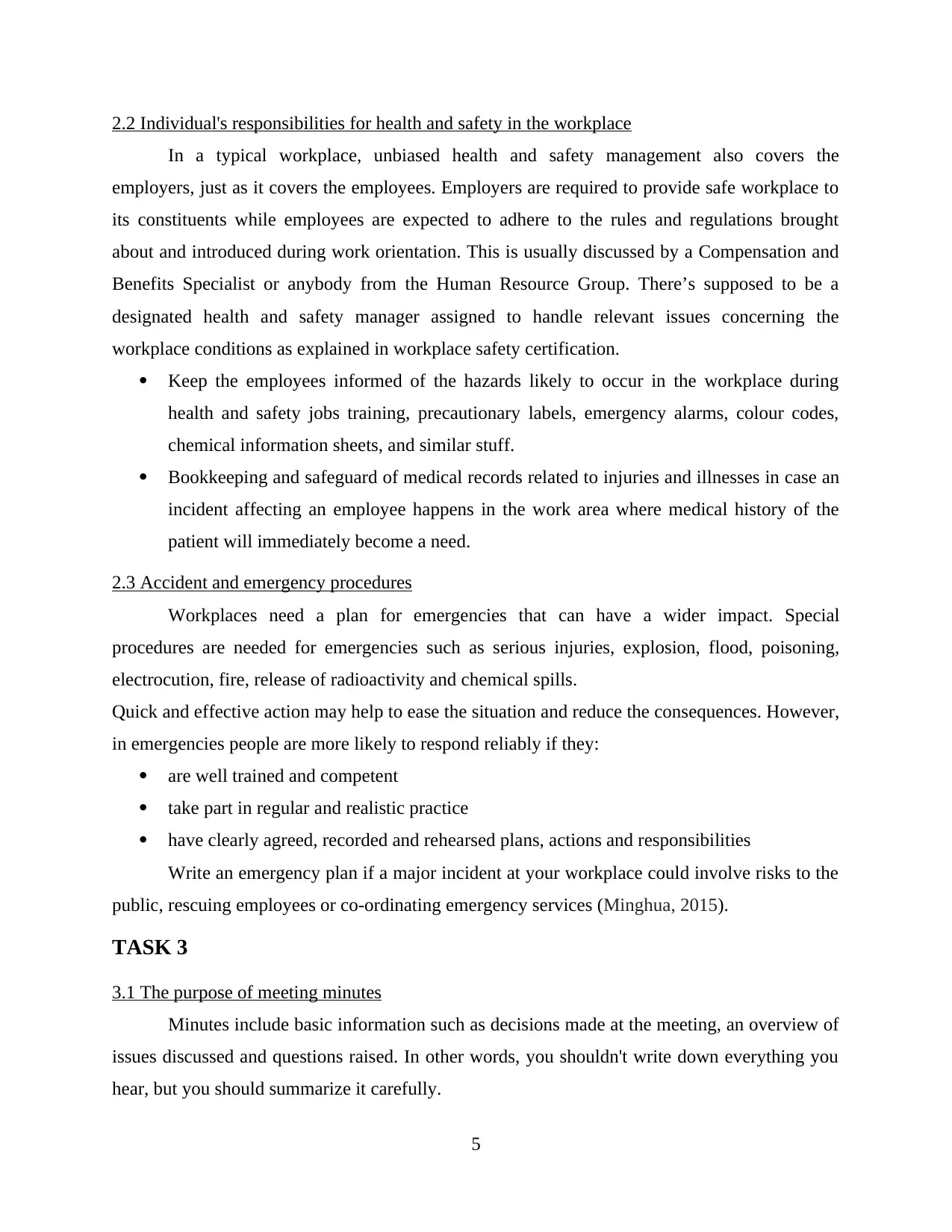
2.2 Individual's responsibilities for health and safety in the workplace
In a typical workplace, unbiased health and safety management also covers the
employers, just as it covers the employees. Employers are required to provide safe workplace to
its constituents while employees are expected to adhere to the rules and regulations brought
about and introduced during work orientation. This is usually discussed by a Compensation and
Benefits Specialist or anybody from the Human Resource Group. There’s supposed to be a
designated health and safety manager assigned to handle relevant issues concerning the
workplace conditions as explained in workplace safety certification.
Keep the employees informed of the hazards likely to occur in the workplace during
health and safety jobs training, precautionary labels, emergency alarms, colour codes,
chemical information sheets, and similar stuff.
Bookkeeping and safeguard of medical records related to injuries and illnesses in case an
incident affecting an employee happens in the work area where medical history of the
patient will immediately become a need.
2.3 Accident and emergency procedures
Workplaces need a plan for emergencies that can have a wider impact. Special
procedures are needed for emergencies such as serious injuries, explosion, flood, poisoning,
electrocution, fire, release of radioactivity and chemical spills.
Quick and effective action may help to ease the situation and reduce the consequences. However,
in emergencies people are more likely to respond reliably if they:
are well trained and competent
take part in regular and realistic practice
have clearly agreed, recorded and rehearsed plans, actions and responsibilities
Write an emergency plan if a major incident at your workplace could involve risks to the
public, rescuing employees or co-ordinating emergency services (Minghua, 2015).
TASK 3
3.1 The purpose of meeting minutes
Minutes include basic information such as decisions made at the meeting, an overview of
issues discussed and questions raised. In other words, you shouldn't write down everything you
hear, but you should summarize it carefully.
5
In a typical workplace, unbiased health and safety management also covers the
employers, just as it covers the employees. Employers are required to provide safe workplace to
its constituents while employees are expected to adhere to the rules and regulations brought
about and introduced during work orientation. This is usually discussed by a Compensation and
Benefits Specialist or anybody from the Human Resource Group. There’s supposed to be a
designated health and safety manager assigned to handle relevant issues concerning the
workplace conditions as explained in workplace safety certification.
Keep the employees informed of the hazards likely to occur in the workplace during
health and safety jobs training, precautionary labels, emergency alarms, colour codes,
chemical information sheets, and similar stuff.
Bookkeeping and safeguard of medical records related to injuries and illnesses in case an
incident affecting an employee happens in the work area where medical history of the
patient will immediately become a need.
2.3 Accident and emergency procedures
Workplaces need a plan for emergencies that can have a wider impact. Special
procedures are needed for emergencies such as serious injuries, explosion, flood, poisoning,
electrocution, fire, release of radioactivity and chemical spills.
Quick and effective action may help to ease the situation and reduce the consequences. However,
in emergencies people are more likely to respond reliably if they:
are well trained and competent
take part in regular and realistic practice
have clearly agreed, recorded and rehearsed plans, actions and responsibilities
Write an emergency plan if a major incident at your workplace could involve risks to the
public, rescuing employees or co-ordinating emergency services (Minghua, 2015).
TASK 3
3.1 The purpose of meeting minutes
Minutes include basic information such as decisions made at the meeting, an overview of
issues discussed and questions raised. In other words, you shouldn't write down everything you
hear, but you should summarize it carefully.
5
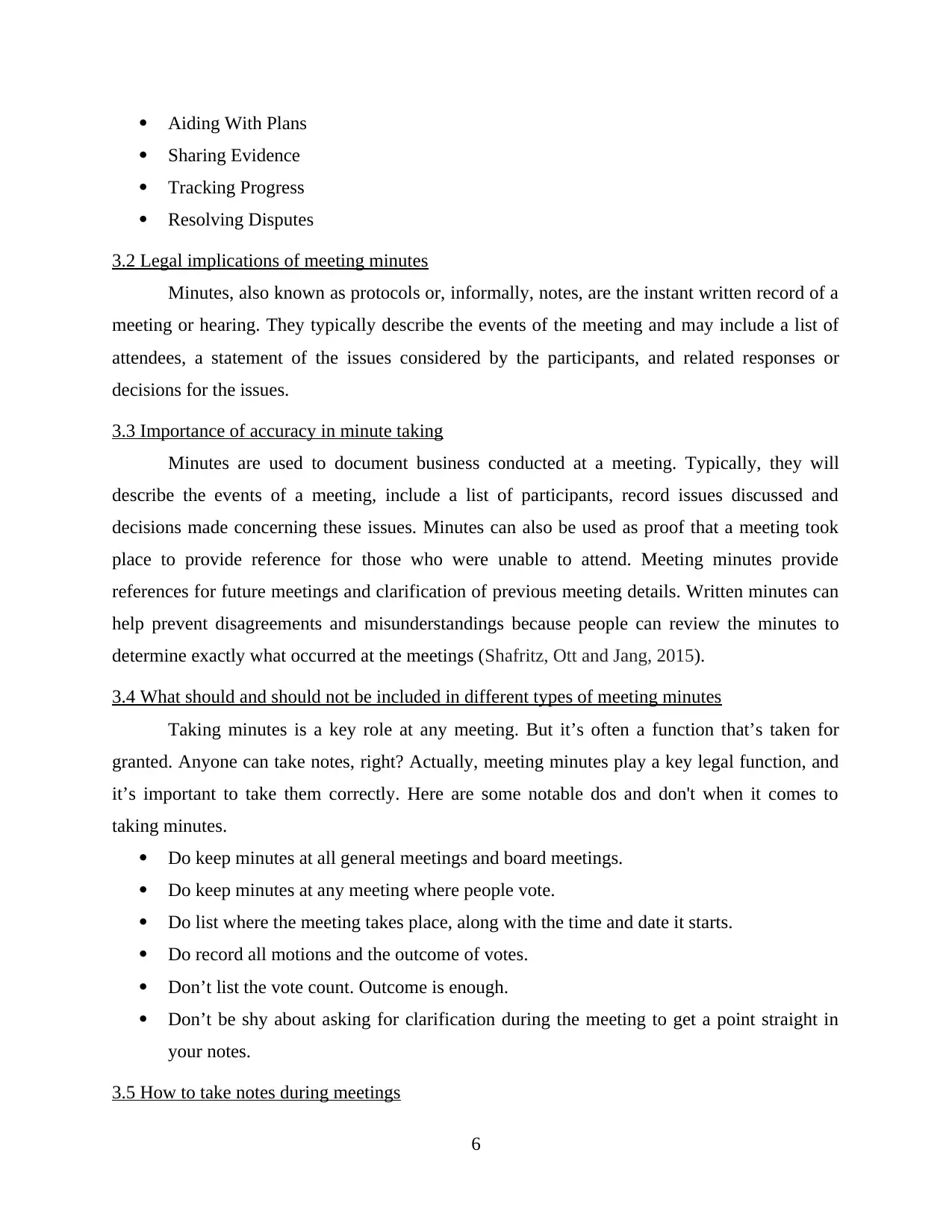
Aiding With Plans
Sharing Evidence
Tracking Progress
Resolving Disputes
3.2 Legal implications of meeting minutes
Minutes, also known as protocols or, informally, notes, are the instant written record of a
meeting or hearing. They typically describe the events of the meeting and may include a list of
attendees, a statement of the issues considered by the participants, and related responses or
decisions for the issues.
3.3 Importance of accuracy in minute taking
Minutes are used to document business conducted at a meeting. Typically, they will
describe the events of a meeting, include a list of participants, record issues discussed and
decisions made concerning these issues. Minutes can also be used as proof that a meeting took
place to provide reference for those who were unable to attend. Meeting minutes provide
references for future meetings and clarification of previous meeting details. Written minutes can
help prevent disagreements and misunderstandings because people can review the minutes to
determine exactly what occurred at the meetings (Shafritz, Ott and Jang, 2015).
3.4 What should and should not be included in different types of meeting minutes
Taking minutes is a key role at any meeting. But it’s often a function that’s taken for
granted. Anyone can take notes, right? Actually, meeting minutes play a key legal function, and
it’s important to take them correctly. Here are some notable dos and don't when it comes to
taking minutes.
Do keep minutes at all general meetings and board meetings.
Do keep minutes at any meeting where people vote.
Do list where the meeting takes place, along with the time and date it starts.
Do record all motions and the outcome of votes.
Don’t list the vote count. Outcome is enough.
Don’t be shy about asking for clarification during the meeting to get a point straight in
your notes.
3.5 How to take notes during meetings
6
Sharing Evidence
Tracking Progress
Resolving Disputes
3.2 Legal implications of meeting minutes
Minutes, also known as protocols or, informally, notes, are the instant written record of a
meeting or hearing. They typically describe the events of the meeting and may include a list of
attendees, a statement of the issues considered by the participants, and related responses or
decisions for the issues.
3.3 Importance of accuracy in minute taking
Minutes are used to document business conducted at a meeting. Typically, they will
describe the events of a meeting, include a list of participants, record issues discussed and
decisions made concerning these issues. Minutes can also be used as proof that a meeting took
place to provide reference for those who were unable to attend. Meeting minutes provide
references for future meetings and clarification of previous meeting details. Written minutes can
help prevent disagreements and misunderstandings because people can review the minutes to
determine exactly what occurred at the meetings (Shafritz, Ott and Jang, 2015).
3.4 What should and should not be included in different types of meeting minutes
Taking minutes is a key role at any meeting. But it’s often a function that’s taken for
granted. Anyone can take notes, right? Actually, meeting minutes play a key legal function, and
it’s important to take them correctly. Here are some notable dos and don't when it comes to
taking minutes.
Do keep minutes at all general meetings and board meetings.
Do keep minutes at any meeting where people vote.
Do list where the meeting takes place, along with the time and date it starts.
Do record all motions and the outcome of votes.
Don’t list the vote count. Outcome is enough.
Don’t be shy about asking for clarification during the meeting to get a point straight in
your notes.
3.5 How to take notes during meetings
6
⊘ This is a preview!⊘
Do you want full access?
Subscribe today to unlock all pages.

Trusted by 1+ million students worldwide
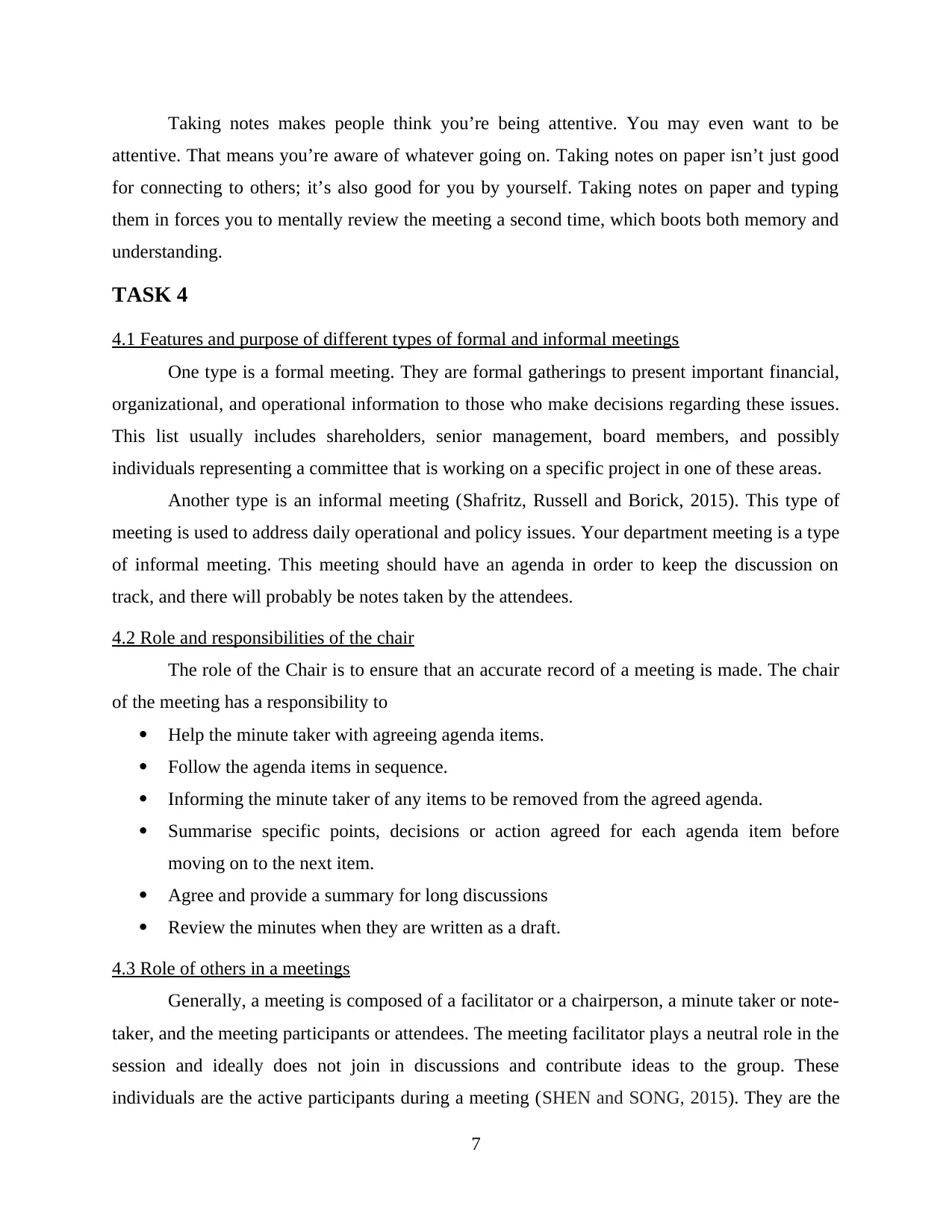
Taking notes makes people think you’re being attentive. You may even want to be
attentive. That means you’re aware of whatever going on. Taking notes on paper isn’t just good
for connecting to others; it’s also good for you by yourself. Taking notes on paper and typing
them in forces you to mentally review the meeting a second time, which boots both memory and
understanding.
TASK 4
4.1 Features and purpose of different types of formal and informal meetings
One type is a formal meeting. They are formal gatherings to present important financial,
organizational, and operational information to those who make decisions regarding these issues.
This list usually includes shareholders, senior management, board members, and possibly
individuals representing a committee that is working on a specific project in one of these areas.
Another type is an informal meeting (Shafritz, Russell and Borick, 2015). This type of
meeting is used to address daily operational and policy issues. Your department meeting is a type
of informal meeting. This meeting should have an agenda in order to keep the discussion on
track, and there will probably be notes taken by the attendees.
4.2 Role and responsibilities of the chair
The role of the Chair is to ensure that an accurate record of a meeting is made. The chair
of the meeting has a responsibility to
Help the minute taker with agreeing agenda items.
Follow the agenda items in sequence.
Informing the minute taker of any items to be removed from the agreed agenda.
Summarise specific points, decisions or action agreed for each agenda item before
moving on to the next item.
Agree and provide a summary for long discussions
Review the minutes when they are written as a draft.
4.3 Role of others in a meetings
Generally, a meeting is composed of a facilitator or a chairperson, a minute taker or note-
taker, and the meeting participants or attendees. The meeting facilitator plays a neutral role in the
session and ideally does not join in discussions and contribute ideas to the group. These
individuals are the active participants during a meeting (SHEN and SONG, 2015). They are the
7
attentive. That means you’re aware of whatever going on. Taking notes on paper isn’t just good
for connecting to others; it’s also good for you by yourself. Taking notes on paper and typing
them in forces you to mentally review the meeting a second time, which boots both memory and
understanding.
TASK 4
4.1 Features and purpose of different types of formal and informal meetings
One type is a formal meeting. They are formal gatherings to present important financial,
organizational, and operational information to those who make decisions regarding these issues.
This list usually includes shareholders, senior management, board members, and possibly
individuals representing a committee that is working on a specific project in one of these areas.
Another type is an informal meeting (Shafritz, Russell and Borick, 2015). This type of
meeting is used to address daily operational and policy issues. Your department meeting is a type
of informal meeting. This meeting should have an agenda in order to keep the discussion on
track, and there will probably be notes taken by the attendees.
4.2 Role and responsibilities of the chair
The role of the Chair is to ensure that an accurate record of a meeting is made. The chair
of the meeting has a responsibility to
Help the minute taker with agreeing agenda items.
Follow the agenda items in sequence.
Informing the minute taker of any items to be removed from the agreed agenda.
Summarise specific points, decisions or action agreed for each agenda item before
moving on to the next item.
Agree and provide a summary for long discussions
Review the minutes when they are written as a draft.
4.3 Role of others in a meetings
Generally, a meeting is composed of a facilitator or a chairperson, a minute taker or note-
taker, and the meeting participants or attendees. The meeting facilitator plays a neutral role in the
session and ideally does not join in discussions and contribute ideas to the group. These
individuals are the active participants during a meeting (SHEN and SONG, 2015). They are the
7
Paraphrase This Document
Need a fresh take? Get an instant paraphrase of this document with our AI Paraphraser
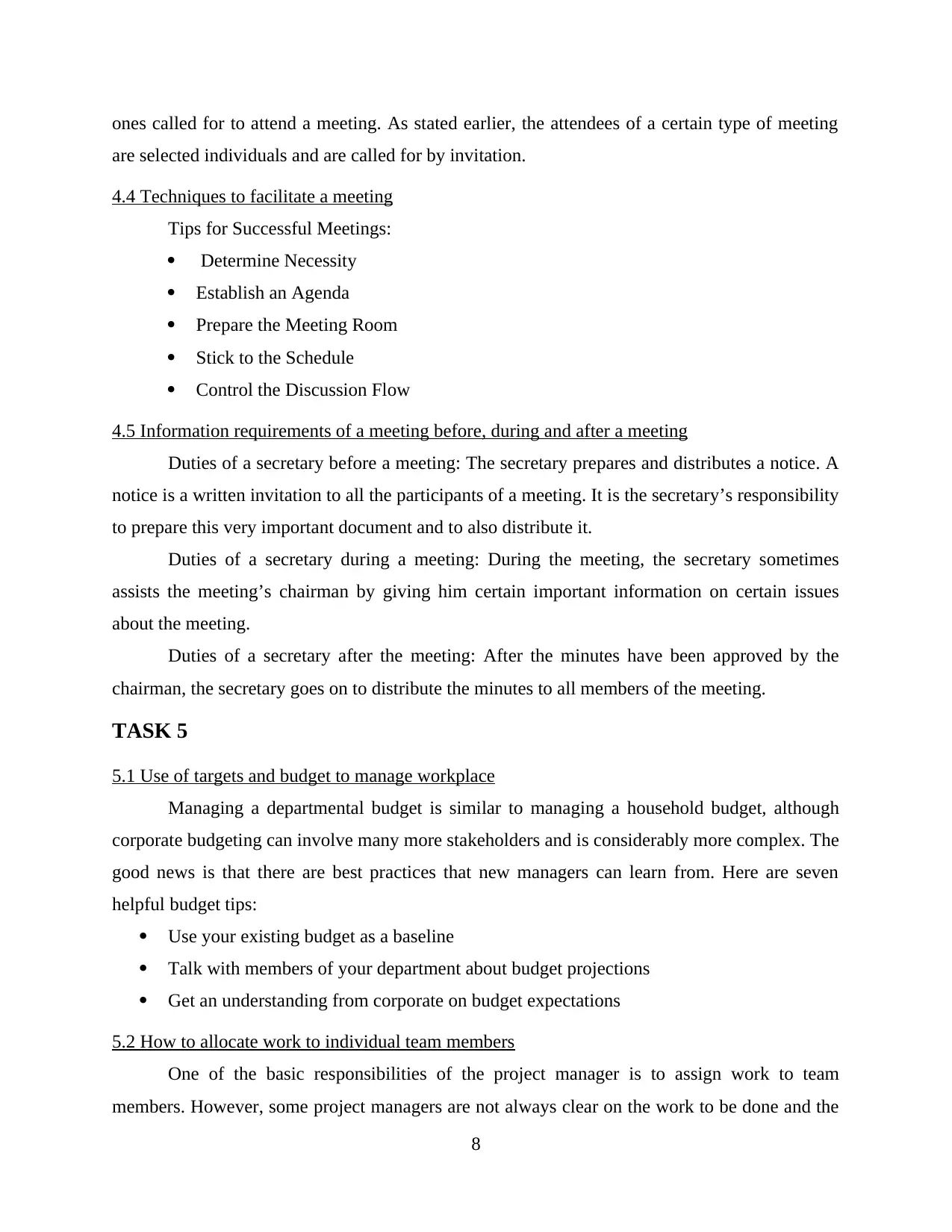
ones called for to attend a meeting. As stated earlier, the attendees of a certain type of meeting
are selected individuals and are called for by invitation.
4.4 Techniques to facilitate a meeting
Tips for Successful Meetings:
Determine Necessity
Establish an Agenda
Prepare the Meeting Room
Stick to the Schedule
Control the Discussion Flow
4.5 Information requirements of a meeting before, during and after a meeting
Duties of a secretary before a meeting: The secretary prepares and distributes a notice. A
notice is a written invitation to all the participants of a meeting. It is the secretary’s responsibility
to prepare this very important document and to also distribute it.
Duties of a secretary during a meeting: During the meeting, the secretary sometimes
assists the meeting’s chairman by giving him certain important information on certain issues
about the meeting.
Duties of a secretary after the meeting: After the minutes have been approved by the
chairman, the secretary goes on to distribute the minutes to all members of the meeting.
TASK 5
5.1 Use of targets and budget to manage workplace
Managing a departmental budget is similar to managing a household budget, although
corporate budgeting can involve many more stakeholders and is considerably more complex. The
good news is that there are best practices that new managers can learn from. Here are seven
helpful budget tips:
Use your existing budget as a baseline
Talk with members of your department about budget projections
Get an understanding from corporate on budget expectations
5.2 How to allocate work to individual team members
One of the basic responsibilities of the project manager is to assign work to team
members. However, some project managers are not always clear on the work to be done and the
8
are selected individuals and are called for by invitation.
4.4 Techniques to facilitate a meeting
Tips for Successful Meetings:
Determine Necessity
Establish an Agenda
Prepare the Meeting Room
Stick to the Schedule
Control the Discussion Flow
4.5 Information requirements of a meeting before, during and after a meeting
Duties of a secretary before a meeting: The secretary prepares and distributes a notice. A
notice is a written invitation to all the participants of a meeting. It is the secretary’s responsibility
to prepare this very important document and to also distribute it.
Duties of a secretary during a meeting: During the meeting, the secretary sometimes
assists the meeting’s chairman by giving him certain important information on certain issues
about the meeting.
Duties of a secretary after the meeting: After the minutes have been approved by the
chairman, the secretary goes on to distribute the minutes to all members of the meeting.
TASK 5
5.1 Use of targets and budget to manage workplace
Managing a departmental budget is similar to managing a household budget, although
corporate budgeting can involve many more stakeholders and is considerably more complex. The
good news is that there are best practices that new managers can learn from. Here are seven
helpful budget tips:
Use your existing budget as a baseline
Talk with members of your department about budget projections
Get an understanding from corporate on budget expectations
5.2 How to allocate work to individual team members
One of the basic responsibilities of the project manager is to assign work to team
members. However, some project managers are not always clear on the work to be done and the
8
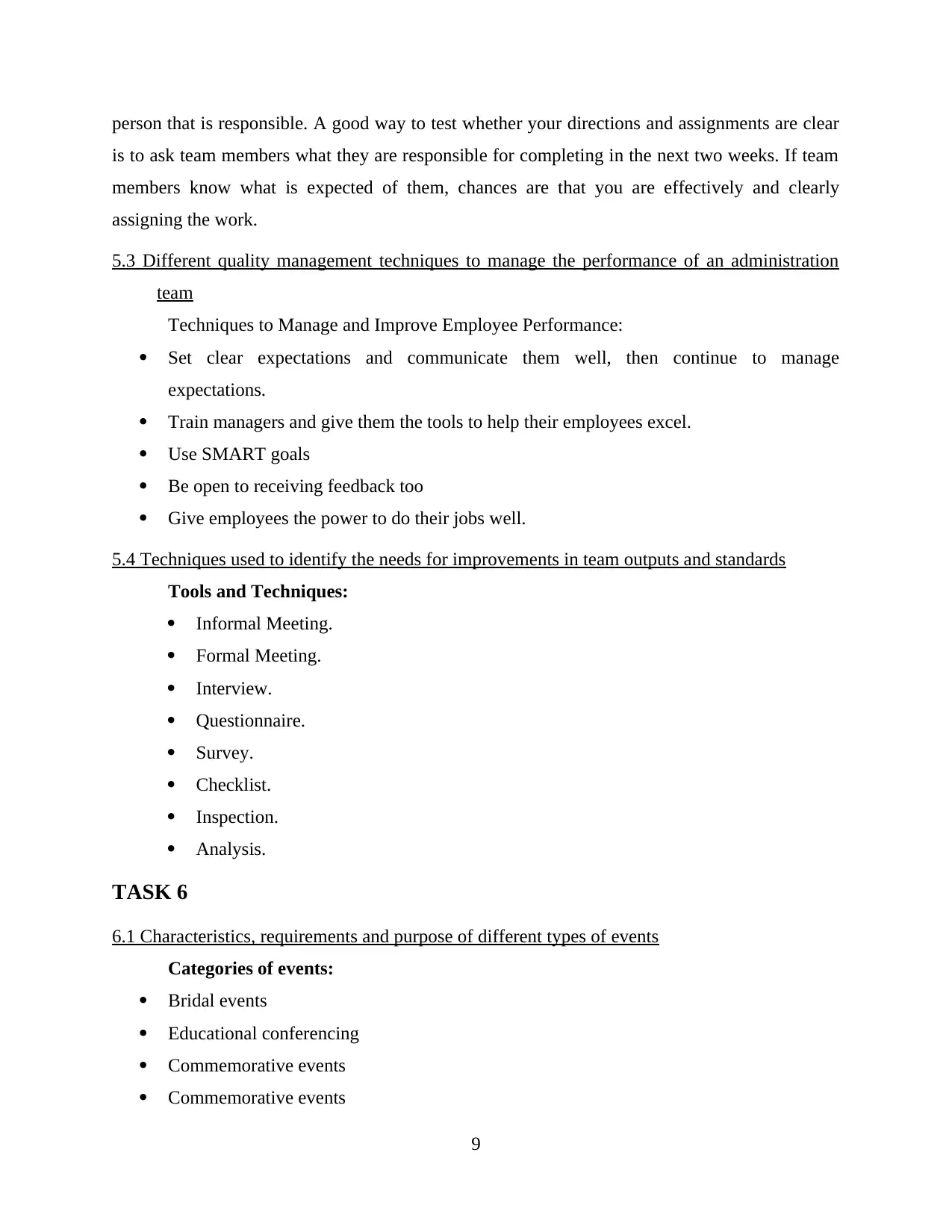
person that is responsible. A good way to test whether your directions and assignments are clear
is to ask team members what they are responsible for completing in the next two weeks. If team
members know what is expected of them, chances are that you are effectively and clearly
assigning the work.
5.3 Different quality management techniques to manage the performance of an administration
team
Techniques to Manage and Improve Employee Performance:
Set clear expectations and communicate them well, then continue to manage
expectations.
Train managers and give them the tools to help their employees excel.
Use SMART goals
Be open to receiving feedback too
Give employees the power to do their jobs well.
5.4 Techniques used to identify the needs for improvements in team outputs and standards
Tools and Techniques:
Informal Meeting.
Formal Meeting.
Interview.
Questionnaire.
Survey.
Checklist.
Inspection.
Analysis.
TASK 6
6.1 Characteristics, requirements and purpose of different types of events
Categories of events:
Bridal events
Educational conferencing
Commemorative events
Commemorative events
9
is to ask team members what they are responsible for completing in the next two weeks. If team
members know what is expected of them, chances are that you are effectively and clearly
assigning the work.
5.3 Different quality management techniques to manage the performance of an administration
team
Techniques to Manage and Improve Employee Performance:
Set clear expectations and communicate them well, then continue to manage
expectations.
Train managers and give them the tools to help their employees excel.
Use SMART goals
Be open to receiving feedback too
Give employees the power to do their jobs well.
5.4 Techniques used to identify the needs for improvements in team outputs and standards
Tools and Techniques:
Informal Meeting.
Formal Meeting.
Interview.
Questionnaire.
Survey.
Checklist.
Inspection.
Analysis.
TASK 6
6.1 Characteristics, requirements and purpose of different types of events
Categories of events:
Bridal events
Educational conferencing
Commemorative events
Commemorative events
9
⊘ This is a preview!⊘
Do you want full access?
Subscribe today to unlock all pages.

Trusted by 1+ million students worldwide
1 out of 16
Related Documents
Your All-in-One AI-Powered Toolkit for Academic Success.
+13062052269
info@desklib.com
Available 24*7 on WhatsApp / Email
![[object Object]](/_next/static/media/star-bottom.7253800d.svg)
Unlock your academic potential
Copyright © 2020–2025 A2Z Services. All Rights Reserved. Developed and managed by ZUCOL.





